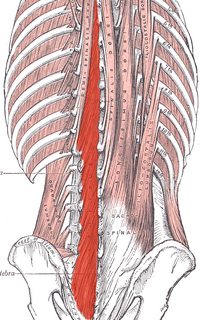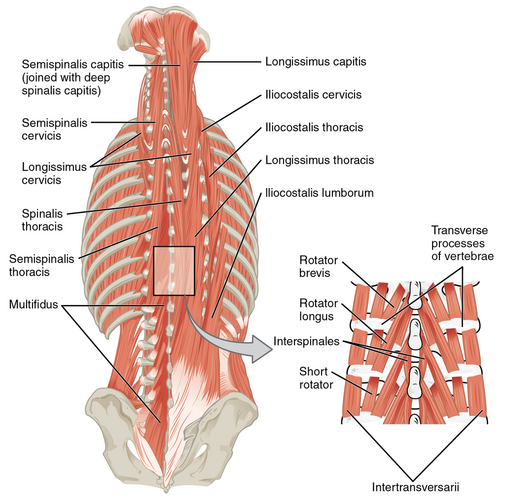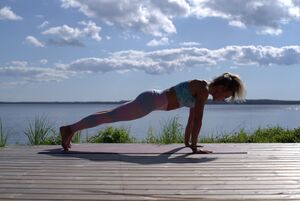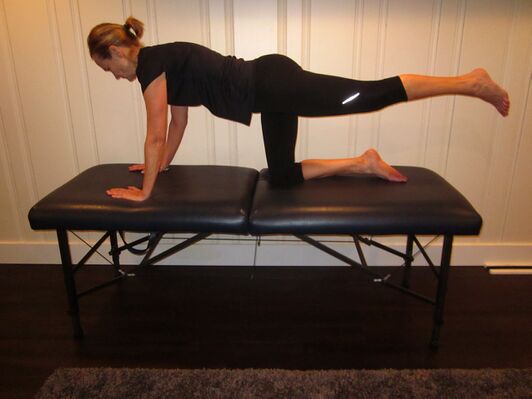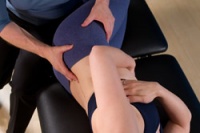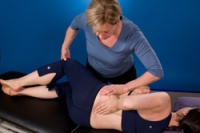Lumbar Multifidus
Top Contributors - Lucinda hampton and Kim Jackson
Description[edit | edit source]
The multifidus muscle is from the deep muscles of the back that together with the semispinalis and rotatores form the transversospinales muscles group. Multifidusi lies deep to the semispinalis and superficial to the rotatores.
The trasversospinales muscles group run laterally from the transverse process and attach medially in the spinous process, filling the groove on either side of the spinous process.[1]
The multifidus muscle spans the whole length of the vertebral column but is most developed in the lumbar area.[1] The multifidus muscle is a local core stabilizers , playing an important role in the static and dynamic spinal stability. Weakness in the multifidus muscle is associated with low back pain.[2][3]
Anatomy[edit | edit source]
Origin[edit | edit source]
The lumbar multifidus muscle is a long muscle having several points of origin:
- The back surface of the sacrum.
- The posterior superior iliac spine.
- The mammillary processes of the lumbar vertebrae (bony prominences at the dorsal superior aspect of the lumbar vertebrae).
- The transverse processes of the thoracic vertebrae.[4]
Insertion[edit | edit source]
Base of spinous process of all vertebrae from L5 to T8, 2-4 levels above origin.[1]
The multifidus is connected with the transversus abdominis via the thoracolumbar fascia.
Nerve and Blood Supply[edit | edit source]
Viewing[edit | edit source]
This 1 minute video is a good watch re the multifidus
Action[edit | edit source]
- Bilateral contraction extends the vertebral column.
- Unilateral contraction contralaterally rotates the vertebral coloumn to the opposite side.[1]
- Evidence points to the multifidus muscle being continuously active in upright postures. In fact, the multifidus is probably active in all anti-gravity activity.
- The multifidus stabilizes the vertebrae as the spine moves. It is thought that the unique design of the multifidus endows it with extra strength.
- When the oblique abdominal muscles contract to produce trunk rotation, some flexion of the trunk also occurs. The multifidus muscles oppose this trunk flexion maintaining a pure axial rotation, thus acting as stabilizers during trunk rotation.[7]
Clinical Relevance[edit | edit source]
The multifidus muscle is an important stabilizer of the lumbar spine. It functions together with transversus abdominis and pelvic floor muscles for spine stability. [8]
Multifidus muscle weakness and atrophy is associated with chronic low back pain. Core stabilization programs are suggested to increase multifidus cross section area and decrease low back pain.[5][3]
Trigger points in the multifidus decreases the contraction efficiency of the transversus abdominis due to decreased reciprocal inhibition. Dry needling of the multifidus trigger points increased the thickness of tansversus abdominus during contraction, suggesting that multifidus dry needling can be used for treatment of low back pain.[5]
Length Tension Relationship: The multifidus muscle has high cross section area so its force generating capacity is high and has a low fiber length so its muscle excursion is low.[9] Investigators have categorized multifidus fiber types by layers:
- The deepest layer appears to contributes more strength and stability to the spine than do superficial layers. Possibly because the deep layer only spans 2 vertebral segments (as opposed to up to 4 with the other layers). The resulting shorter "excursion" of the deep layer of the multifidus means that when the muscle contracts, it contributes to more compression type motion at the spinal joint it affects compared to other back extensor muscles and the more superficial layers of the multifidus.[10]
Physiotherapy[edit | edit source]
Treatment: Retraining the stabilising muscles of the core is done in a series of steps.The first step is to learn to isolate the muscle. The second step is to learn to co‐contract it in conjunction with the other muscles of the core. The final step is to co‐contract the entire core (connect simultaneously to the pelvic floor, transversus abdominis & multifidus) in coordination with the larger superficial muscle during functional activities.[11]
See Exercises for Lumbar Instability
Recruitment Training for the Deep Fibers of Lumbosacral Multifidus (dMF)
Lie on your back or side with your spine in a neutral posture, (gentle curve in your low back): [11]
- Try the following connect cues to produce a deep contraction of multifidus isolated from the long back extensors.
- For the part of multifidus that supports the SIJ - imagine a line that connects your left and right SIJ and think about connecting, or drawing together, along this line.
- Imagine a line connecting your groin (or back of your pubic bone) to the part of multifidus in your low back you are trying to train (wake up). Connect along this line and then gently think about suspending (lifting) the lumbar vertebra 1 mm above the one below.
- Breathe in and on the breath out contract the deep multifidus with the best connect cue (have your therapist help you determine which is your best connect cue).[11]
- No movement of your hips, pelvis or spine should occur as you gently activate the dMF. If you compare how heavy your leg is to lift with and without this dMF contraction you should find that it is lighter with the proper contraction.
- Hold the contraction for 3- 5 seconds and then release and breathe throughout this exercise. Repeat the contraction and hold for 3 sets of 10 repetitions 3 – 4 times per day for 4 weeks.
Strength Training for Lumbosacral Multifidus
In side lying:
- Maintaining your connection to Transverse Abdominus (TrA), keep your ankles together and lift your top knee (only as high as you can control without breath holding), focus on turning your inner thigh outwards. Return your knee.[11]
- Maintaining your connection to TrA, keep your ankles together, lift your top knee and then lift your ankle. Return your ankle and then your knee.
- Lying on your back with your knees and hips flexed:
- Slowly let your right knee move to the right, keep your low back and pelvis level. Return to the centre and repeat with the left.
- Lift the right foot off the floor keeping the knee bent. Don’t hold your breath and don’t bulge your lower abdomen. Return the foot to the floor and repeat with the left foot. There should be no clicking in your low back.[11]
- Lift the right foot off the floor and then straighten the leg only as far as you can control your core with a proper strategy. Slowly bend the knee and return the foot to the floor. Repeat with the left leg.Lift the right foot off the floor and then the left foot off the floor. Alternate
- leg extensions, exert with exhalation, breathe in to rest or hold.
With all these exercises maintain the leg lift for 10 seconds, build to 3 sets of 10 repetitions before moving on
Incorporate into Other Activities
The final step is to remember to use the core during regular life activities. Each time you get out of the chair, lift, bend or reach, this local stabilising system should be working at a low level. The goal is to teach the body to resume its normal stabilisation strategy of connecting to the core before movement begins.
Multifidus and back Pain[edit | edit source]
Have a look at this 2 min 30 sec. video for some good information of evidence regarding multifidus and low back problems.
References[edit | edit source]
- ↑ 1.0 1.1 1.2 1.3 1.4 Drake R, Vogl AW, Mitchell AW. Gray's Anatomy for Students E-Book. Elsevier Health Sciences; 2009 Apr 4.
- ↑ Zheng Y, Ke S, Lin C, Li X, Liu C, Wu Y, Xin W, Ma C, Wu S. Effect of Core Stability Training Monitored by Rehabilitative Ultrasound Image and Surface Electromyogram in Local Core Muscles of Healthy People. Pain Research and Management. 2019;2019.
- ↑ 3.0 3.1 Kliziene I, Sipaviciene S, Klizas S, Imbrasiene D. Effects of core stability exercises on multifidus muscles in healthy women and women with chronic low-back pain. Journal of back and musculoskeletal rehabilitation. 2015 Jan 1;28(4):841-7.
- ↑ Study,com Multifidus Available:https://study.com/academy/lesson/multifidus-muscle-origin-insertion-action.html (accessed 29.1.2022)
- ↑ 5.0 5.1 5.2 Goubert D, Van Oosterwijck J, Meeus M, Danneels L. Structural changes of lumbar muscles in non-specific low back pain. Pain physician. 2016;19(7):E985-99.
- ↑ J Fitzgordon The mutifidus muscle available from: https://www.youtube.com/watch?v=c-_Y9q-kLdc (last accessed 9.6.2019)
- ↑ Physiopedia Lumbar Multifidus Available:Lumbar Multifidus (accessed 29.1.2022)
- ↑ Lynders C. The Critical Role of Development of the Transversus Abdominis in the Prevention and Treatment of Low Back Pain. HSS Journal®. 2019 Oct 1;15(3):214-20.
- ↑ Architectural Analysis and Intraoperative Measurements Demonstrate the Unique Design of the Multifidus Muscle for Lumbar Spine StabilityfckLRSamuel R. Ward, PT, PhD,1 Choll W. Kim, MD, PhD,1 Carolyn M. Eng, BS,1 Lionel J. Gottschalk, IV, BS,1 Akihito Tomiya, MD, PhD,1 Steven R. Garfin, MD,1 and Richard L. Lieber, PhD1
- ↑ Physiopedia Multifidus Available: Lumbar Multifidus (accessed 29.1.2022)
- ↑ 11.0 11.1 11.2 11.3 11.4 diane lee Empower through Knowledge, Movement & Awareness Available from: https://dianelee.ca/article-training-deep-core-muscles.php (last accessed 9.6.2019)
- ↑ Chris Centeno Multifidus Back Pain: Why Your Doctor Never Discussed It Available from: https://www.youtube.com/watch?v=jjAWBiO7h4E (last accessed 8.6.2019)
